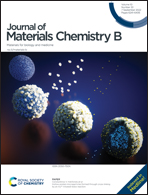Mesoporous polydopamine nanoparticles for sustained release of rapamycin and reactive oxygen species scavenging to synergistically accelerate neurogenesis after spinal cord injury†
Abstract
Spinal cord injury (SCI) is an intractable condition with complex pathological processes and poor prognosis. Reactive oxygen species (ROS) generation induced by the mammalian target of the rapamycin (mTOR) protein is one of the causes of secondary inflammation of SCI. Rapamycin (Rapa) is a pharmacological inhibitor of mTOR, which can inhibit ROS overproduction mediated by abnormal activation of the mTOR protein. Polydopamine, as a nanocarrier with excellent biological safety, has been reported to possess satisfactory ROS scavenging ability. Therefore, we designed a mesoporous polydopamine nanoparticle loaded with Rapa (mPDA@Rapa) for combination therapy, which simultaneously inhibited abnormally activated mTOR-mediated ROS production and eliminated already generated ROS. The synthesized mPDA nanoparticles could realize the effective encapsulation and sustained release of Rapa due to their mesoporous cavities and a hydrophobic benzene ring structure. In vitro experiments proved that mPDA@Rapa nanoparticles had a good ROS scavenging ability towards hydrogen peroxide and hydroxyl radicals. Furthermore, mPDA@Rapa also showed a good therapeutic effect in SCI model rats, which was evidenced by a smaller injury cavity, more coordinated hind limb movements, and a higher degree of neurogenesis and tissue regeneration. Our work provides a combined strategy to inhibit ROS overproduction and eliminate excess ROS, with potential applications not only in SCI, but also in other ROS-induced inflammations.



 Please wait while we load your content...
Please wait while we load your content...